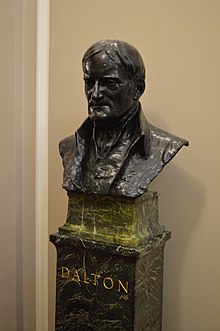Bust of John Dalton

The bronze bust of John Dalton located along the corridor on the first floor of Burlington House, London, was created by Ruby Levick[1][2][3] (who also executed the bust of Humphry Davy at Burlington House) and donated to the Chemical Society in 1903 by its former president Sir Thomas Edward Thorpe (1845–1925),[4] as attested by the inscription engraved on the bust's base: "John Dalton presented by T.E. Thorpe CB. L.L.D. F.R.S. past president in commemoration of the centenary of the enunciation of the atomic theory".
A copy of his accompanying letter was printed in the Proceedings of the Chemical Society in 1903 and read out by president professor William A. Tilden:
"The bronze is the work of Miss Levick, who is already favourably known to the Society by her reproduction of the bust of Davy in their possession. Of the artistic merits of her present work others must be the judge, but I may be permitted here to express my indebtedness to her for the skill and conscientious care with which she has striven to make a faithful and adequate presentment of the grand old philosopher".[5]
John Dalton (1766–1844) was an English chemist best known for his development of atomic theory.
See also[edit]
References[edit]
- ^ "'Miss Ruby Levick' Mapping the Practice and Profession of Sculpture in Britain and Ireland 1851–1951". University of Glasgow History of Art and HATII, online database 2011.
- ^ T. Martin Wood. "A Decorative Sculptor: Miss Ruby Levick: (Mrs. Gervaise Bailey)". The Victorian Web.
- ^ "Ruby Levick". Oxford Dictionary of National Biography. Oxford University Press.
- ^ Allen, David (2010). The Historical Collection at the Chemistry Centre. London: Royal Society of Chemistry. p. 30.
- ^ "Proceedings of the Chemical Society". Proceedings of the Chemical Society. 19: 212–213. 1903.
External links[edit]
 Media related to Bust of John Dalton, Royal Society of Chemistry at Wikimedia Commons
Media related to Bust of John Dalton, Royal Society of Chemistry at Wikimedia Commons
